A Detailed Analysis: Mintzberg's Theory of Management in Business
VerifiedAdded on 2020/04/21
|12
|2594
|340
Report
AI Summary
This report provides a detailed analysis of Henry Mintzberg's theory of management, focusing on the ten essential roles managers must fulfill: figurehead, leader, liaison, monitor, disseminator, spokesperson, entrepreneur, disturbance handler, resource allocator, and negotiator. The report categorizes these roles into interpersonal, informational, and decisional aspects, emphasizing their continued relevance in the current fast-paced business environment. It examines how these roles apply to modern management responsibilities such as recruiting, planning, organizing, communication, business growth, conflict management, sales, marketing, decision-making, training, financial management, performance management, motivation, and representation. The report concludes that Mintzberg's framework remains a valuable tool for managers navigating the complexities of contemporary business, offering a comprehensive understanding of their diverse responsibilities and how to effectively lead teams and drive organizational success. The report highlights the practical applications of each role and underscores the importance of adapting Mintzberg's principles to address challenges and achieve goals in today's competitive landscape.

Running Head: Business Management
Business Management
Mintzberg’s theory of management
Business Management
Mintzberg’s theory of management
Paraphrase This Document
Need a fresh take? Get an instant paraphrase of this document with our AI Paraphraser
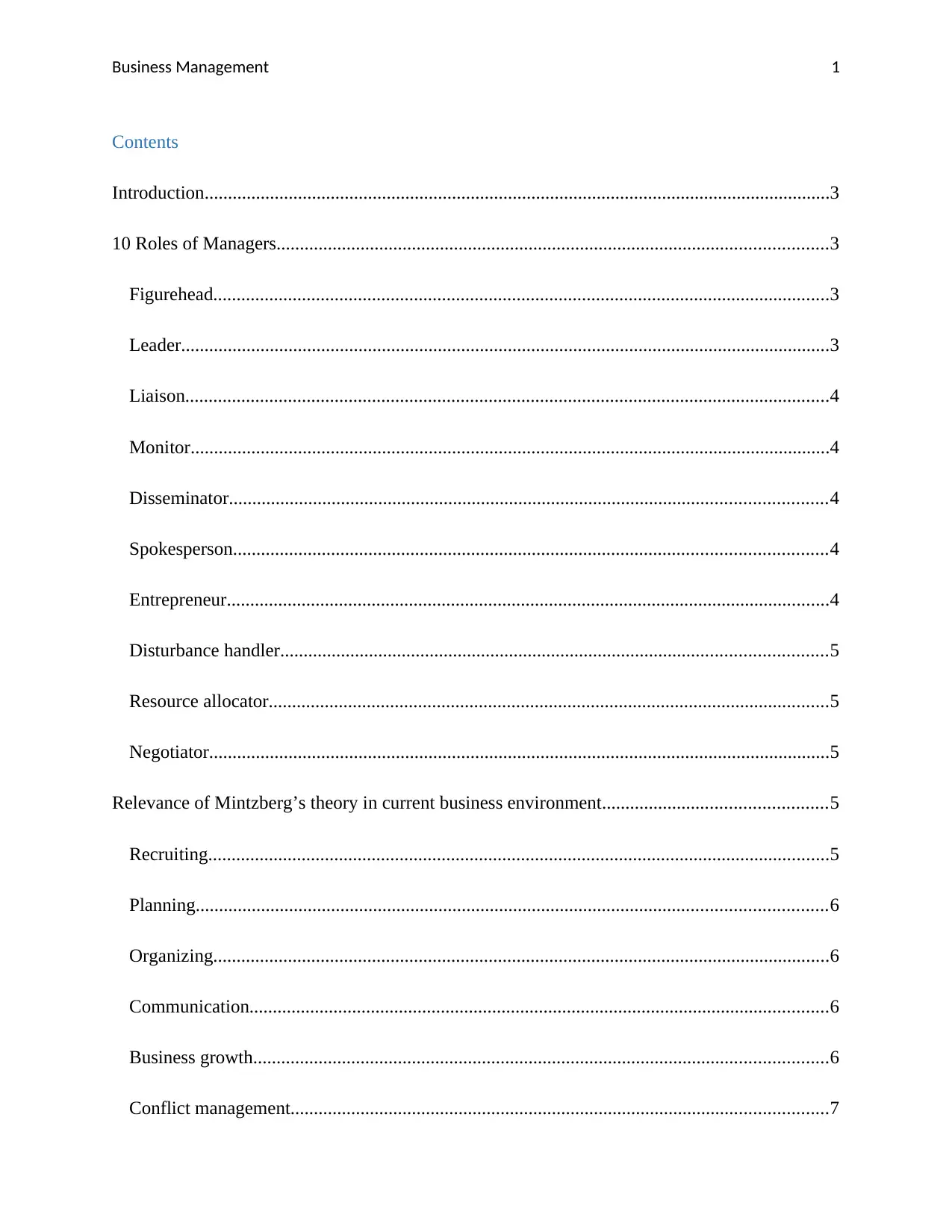
Business Management 1
Contents
Introduction......................................................................................................................................3
10 Roles of Managers......................................................................................................................3
Figurehead....................................................................................................................................3
Leader...........................................................................................................................................3
Liaison..........................................................................................................................................4
Monitor.........................................................................................................................................4
Disseminator................................................................................................................................4
Spokesperson...............................................................................................................................4
Entrepreneur.................................................................................................................................4
Disturbance handler.....................................................................................................................5
Resource allocator........................................................................................................................5
Negotiator.....................................................................................................................................5
Relevance of Mintzberg’s theory in current business environment................................................5
Recruiting.....................................................................................................................................5
Planning.......................................................................................................................................6
Organizing....................................................................................................................................6
Communication............................................................................................................................6
Business growth...........................................................................................................................6
Conflict management...................................................................................................................7
Contents
Introduction......................................................................................................................................3
10 Roles of Managers......................................................................................................................3
Figurehead....................................................................................................................................3
Leader...........................................................................................................................................3
Liaison..........................................................................................................................................4
Monitor.........................................................................................................................................4
Disseminator................................................................................................................................4
Spokesperson...............................................................................................................................4
Entrepreneur.................................................................................................................................4
Disturbance handler.....................................................................................................................5
Resource allocator........................................................................................................................5
Negotiator.....................................................................................................................................5
Relevance of Mintzberg’s theory in current business environment................................................5
Recruiting.....................................................................................................................................5
Planning.......................................................................................................................................6
Organizing....................................................................................................................................6
Communication............................................................................................................................6
Business growth...........................................................................................................................6
Conflict management...................................................................................................................7
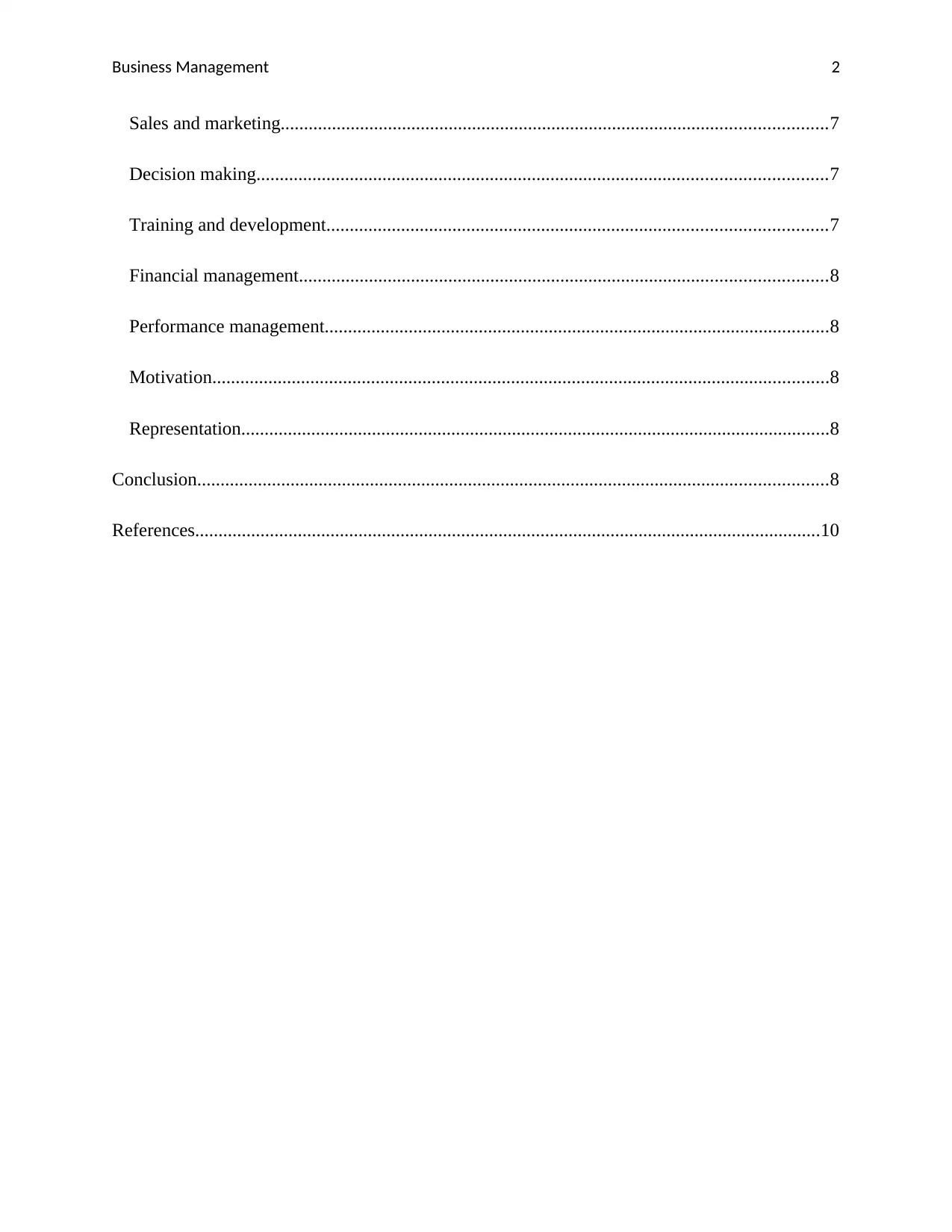
Business Management 2
Sales and marketing.....................................................................................................................7
Decision making..........................................................................................................................7
Training and development...........................................................................................................7
Financial management.................................................................................................................8
Performance management............................................................................................................8
Motivation....................................................................................................................................8
Representation..............................................................................................................................8
Conclusion.......................................................................................................................................8
References......................................................................................................................................10
Sales and marketing.....................................................................................................................7
Decision making..........................................................................................................................7
Training and development...........................................................................................................7
Financial management.................................................................................................................8
Performance management............................................................................................................8
Motivation....................................................................................................................................8
Representation..............................................................................................................................8
Conclusion.......................................................................................................................................8
References......................................................................................................................................10
⊘ This is a preview!⊘
Do you want full access?
Subscribe today to unlock all pages.

Trusted by 1+ million students worldwide
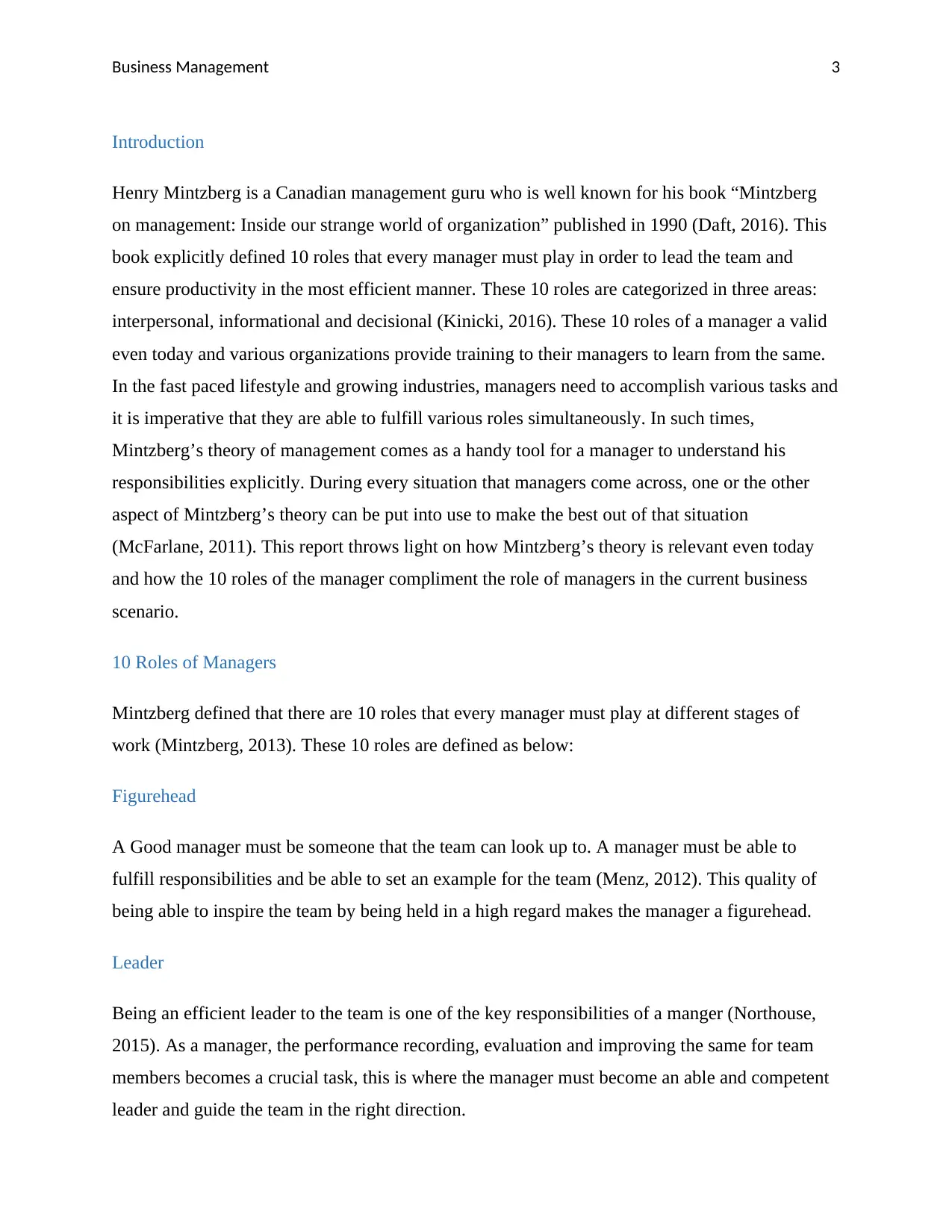
Business Management 3
Introduction
Henry Mintzberg is a Canadian management guru who is well known for his book “Mintzberg
on management: Inside our strange world of organization” published in 1990 (Daft, 2016). This
book explicitly defined 10 roles that every manager must play in order to lead the team and
ensure productivity in the most efficient manner. These 10 roles are categorized in three areas:
interpersonal, informational and decisional (Kinicki, 2016). These 10 roles of a manager a valid
even today and various organizations provide training to their managers to learn from the same.
In the fast paced lifestyle and growing industries, managers need to accomplish various tasks and
it is imperative that they are able to fulfill various roles simultaneously. In such times,
Mintzberg’s theory of management comes as a handy tool for a manager to understand his
responsibilities explicitly. During every situation that managers come across, one or the other
aspect of Mintzberg’s theory can be put into use to make the best out of that situation
(McFarlane, 2011). This report throws light on how Mintzberg’s theory is relevant even today
and how the 10 roles of the manager compliment the role of managers in the current business
scenario.
10 Roles of Managers
Mintzberg defined that there are 10 roles that every manager must play at different stages of
work (Mintzberg, 2013). These 10 roles are defined as below:
Figurehead
A Good manager must be someone that the team can look up to. A manager must be able to
fulfill responsibilities and be able to set an example for the team (Menz, 2012). This quality of
being able to inspire the team by being held in a high regard makes the manager a figurehead.
Leader
Being an efficient leader to the team is one of the key responsibilities of a manger (Northouse,
2015). As a manager, the performance recording, evaluation and improving the same for team
members becomes a crucial task, this is where the manager must become an able and competent
leader and guide the team in the right direction.
Introduction
Henry Mintzberg is a Canadian management guru who is well known for his book “Mintzberg
on management: Inside our strange world of organization” published in 1990 (Daft, 2016). This
book explicitly defined 10 roles that every manager must play in order to lead the team and
ensure productivity in the most efficient manner. These 10 roles are categorized in three areas:
interpersonal, informational and decisional (Kinicki, 2016). These 10 roles of a manager a valid
even today and various organizations provide training to their managers to learn from the same.
In the fast paced lifestyle and growing industries, managers need to accomplish various tasks and
it is imperative that they are able to fulfill various roles simultaneously. In such times,
Mintzberg’s theory of management comes as a handy tool for a manager to understand his
responsibilities explicitly. During every situation that managers come across, one or the other
aspect of Mintzberg’s theory can be put into use to make the best out of that situation
(McFarlane, 2011). This report throws light on how Mintzberg’s theory is relevant even today
and how the 10 roles of the manager compliment the role of managers in the current business
scenario.
10 Roles of Managers
Mintzberg defined that there are 10 roles that every manager must play at different stages of
work (Mintzberg, 2013). These 10 roles are defined as below:
Figurehead
A Good manager must be someone that the team can look up to. A manager must be able to
fulfill responsibilities and be able to set an example for the team (Menz, 2012). This quality of
being able to inspire the team by being held in a high regard makes the manager a figurehead.
Leader
Being an efficient leader to the team is one of the key responsibilities of a manger (Northouse,
2015). As a manager, the performance recording, evaluation and improving the same for team
members becomes a crucial task, this is where the manager must become an able and competent
leader and guide the team in the right direction.
Paraphrase This Document
Need a fresh take? Get an instant paraphrase of this document with our AI Paraphraser
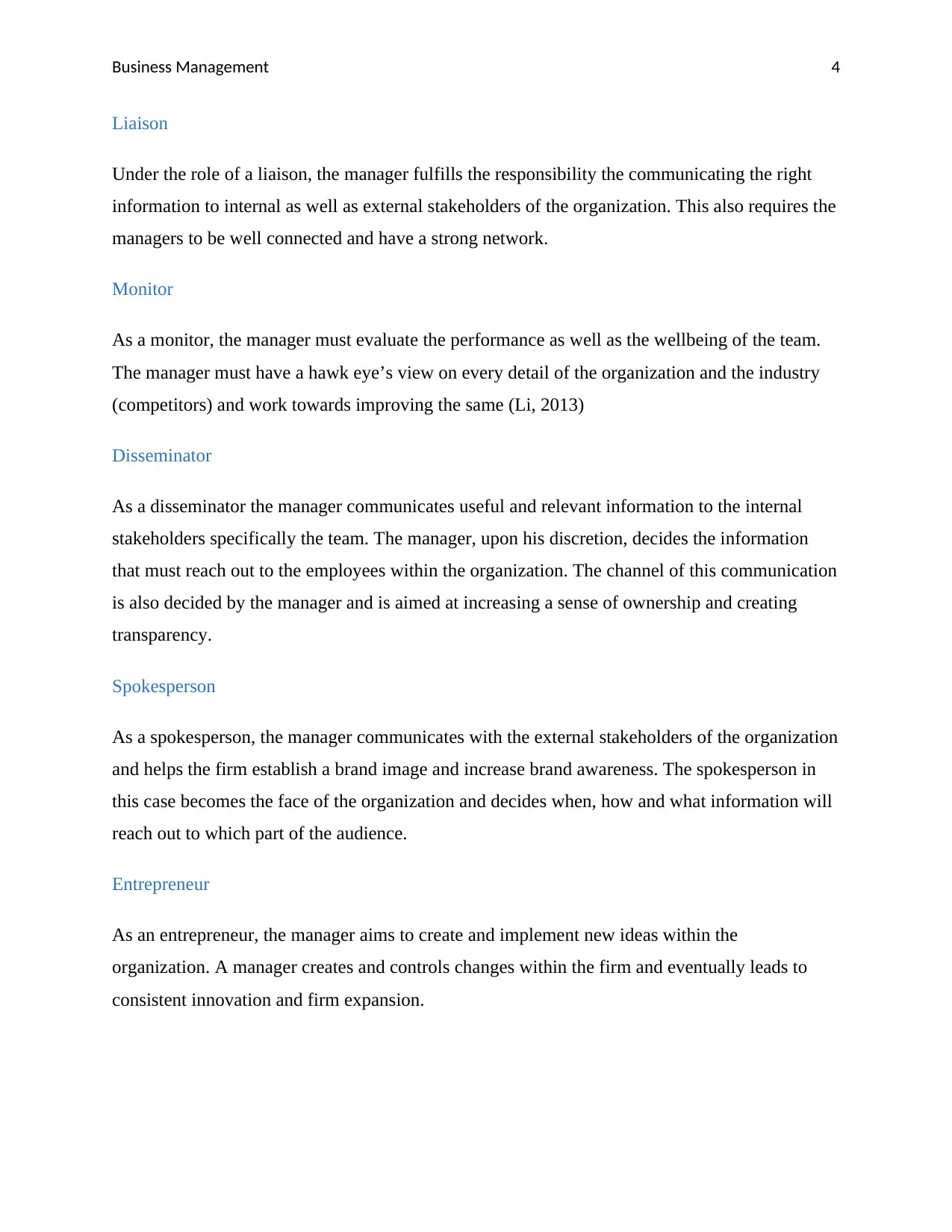
Business Management 4
Liaison
Under the role of a liaison, the manager fulfills the responsibility the communicating the right
information to internal as well as external stakeholders of the organization. This also requires the
managers to be well connected and have a strong network.
Monitor
As a monitor, the manager must evaluate the performance as well as the wellbeing of the team.
The manager must have a hawk eye’s view on every detail of the organization and the industry
(competitors) and work towards improving the same (Li, 2013)
Disseminator
As a disseminator the manager communicates useful and relevant information to the internal
stakeholders specifically the team. The manager, upon his discretion, decides the information
that must reach out to the employees within the organization. The channel of this communication
is also decided by the manager and is aimed at increasing a sense of ownership and creating
transparency.
Spokesperson
As a spokesperson, the manager communicates with the external stakeholders of the organization
and helps the firm establish a brand image and increase brand awareness. The spokesperson in
this case becomes the face of the organization and decides when, how and what information will
reach out to which part of the audience.
Entrepreneur
As an entrepreneur, the manager aims to create and implement new ideas within the
organization. A manager creates and controls changes within the firm and eventually leads to
consistent innovation and firm expansion.
Liaison
Under the role of a liaison, the manager fulfills the responsibility the communicating the right
information to internal as well as external stakeholders of the organization. This also requires the
managers to be well connected and have a strong network.
Monitor
As a monitor, the manager must evaluate the performance as well as the wellbeing of the team.
The manager must have a hawk eye’s view on every detail of the organization and the industry
(competitors) and work towards improving the same (Li, 2013)
Disseminator
As a disseminator the manager communicates useful and relevant information to the internal
stakeholders specifically the team. The manager, upon his discretion, decides the information
that must reach out to the employees within the organization. The channel of this communication
is also decided by the manager and is aimed at increasing a sense of ownership and creating
transparency.
Spokesperson
As a spokesperson, the manager communicates with the external stakeholders of the organization
and helps the firm establish a brand image and increase brand awareness. The spokesperson in
this case becomes the face of the organization and decides when, how and what information will
reach out to which part of the audience.
Entrepreneur
As an entrepreneur, the manager aims to create and implement new ideas within the
organization. A manager creates and controls changes within the firm and eventually leads to
consistent innovation and firm expansion.
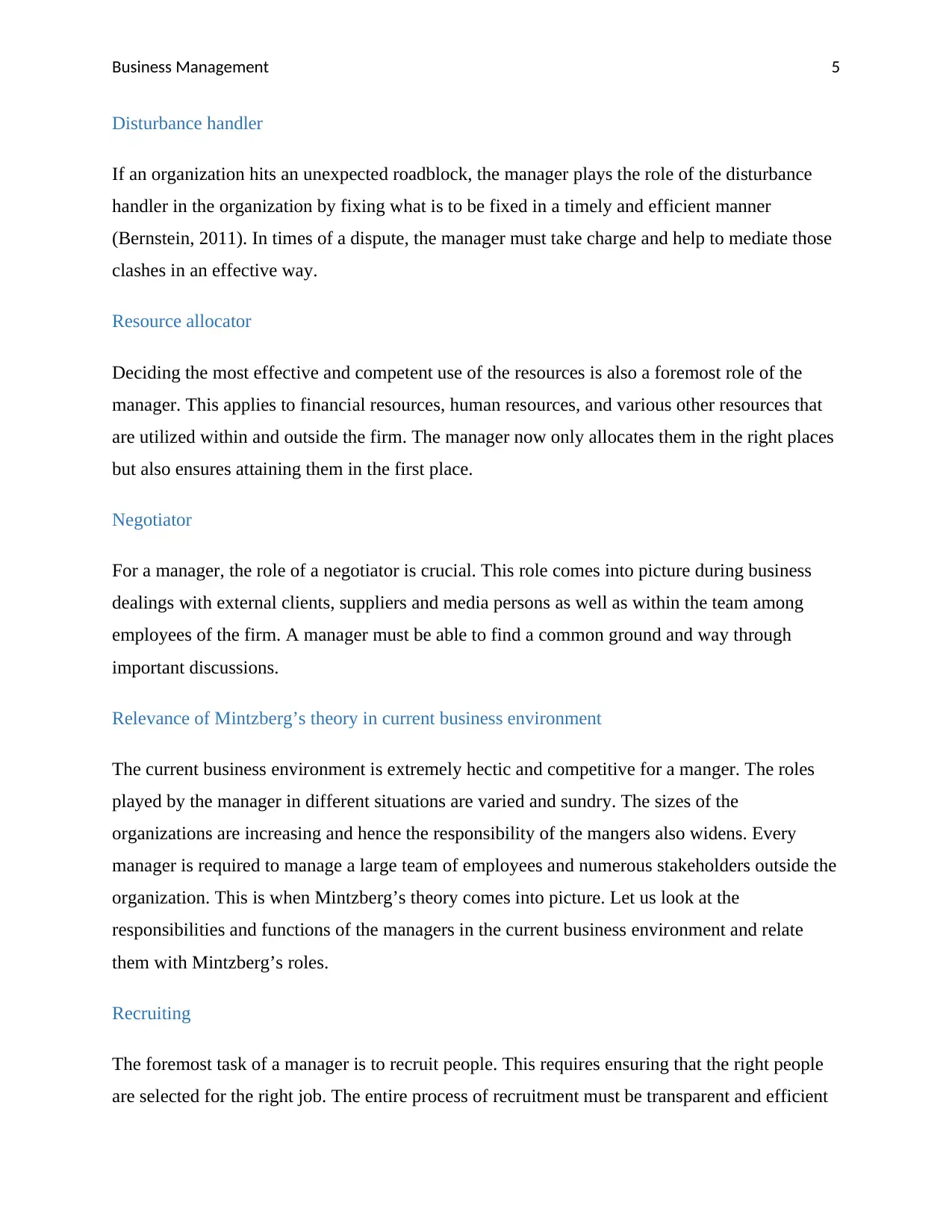
Business Management 5
Disturbance handler
If an organization hits an unexpected roadblock, the manager plays the role of the disturbance
handler in the organization by fixing what is to be fixed in a timely and efficient manner
(Bernstein, 2011). In times of a dispute, the manager must take charge and help to mediate those
clashes in an effective way.
Resource allocator
Deciding the most effective and competent use of the resources is also a foremost role of the
manager. This applies to financial resources, human resources, and various other resources that
are utilized within and outside the firm. The manager now only allocates them in the right places
but also ensures attaining them in the first place.
Negotiator
For a manager, the role of a negotiator is crucial. This role comes into picture during business
dealings with external clients, suppliers and media persons as well as within the team among
employees of the firm. A manager must be able to find a common ground and way through
important discussions.
Relevance of Mintzberg’s theory in current business environment
The current business environment is extremely hectic and competitive for a manger. The roles
played by the manager in different situations are varied and sundry. The sizes of the
organizations are increasing and hence the responsibility of the mangers also widens. Every
manager is required to manage a large team of employees and numerous stakeholders outside the
organization. This is when Mintzberg’s theory comes into picture. Let us look at the
responsibilities and functions of the managers in the current business environment and relate
them with Mintzberg’s roles.
Recruiting
The foremost task of a manager is to recruit people. This requires ensuring that the right people
are selected for the right job. The entire process of recruitment must be transparent and efficient
Disturbance handler
If an organization hits an unexpected roadblock, the manager plays the role of the disturbance
handler in the organization by fixing what is to be fixed in a timely and efficient manner
(Bernstein, 2011). In times of a dispute, the manager must take charge and help to mediate those
clashes in an effective way.
Resource allocator
Deciding the most effective and competent use of the resources is also a foremost role of the
manager. This applies to financial resources, human resources, and various other resources that
are utilized within and outside the firm. The manager now only allocates them in the right places
but also ensures attaining them in the first place.
Negotiator
For a manager, the role of a negotiator is crucial. This role comes into picture during business
dealings with external clients, suppliers and media persons as well as within the team among
employees of the firm. A manager must be able to find a common ground and way through
important discussions.
Relevance of Mintzberg’s theory in current business environment
The current business environment is extremely hectic and competitive for a manger. The roles
played by the manager in different situations are varied and sundry. The sizes of the
organizations are increasing and hence the responsibility of the mangers also widens. Every
manager is required to manage a large team of employees and numerous stakeholders outside the
organization. This is when Mintzberg’s theory comes into picture. Let us look at the
responsibilities and functions of the managers in the current business environment and relate
them with Mintzberg’s roles.
Recruiting
The foremost task of a manager is to recruit people. This requires ensuring that the right people
are selected for the right job. The entire process of recruitment must be transparent and efficient
⊘ This is a preview!⊘
Do you want full access?
Subscribe today to unlock all pages.

Trusted by 1+ million students worldwide
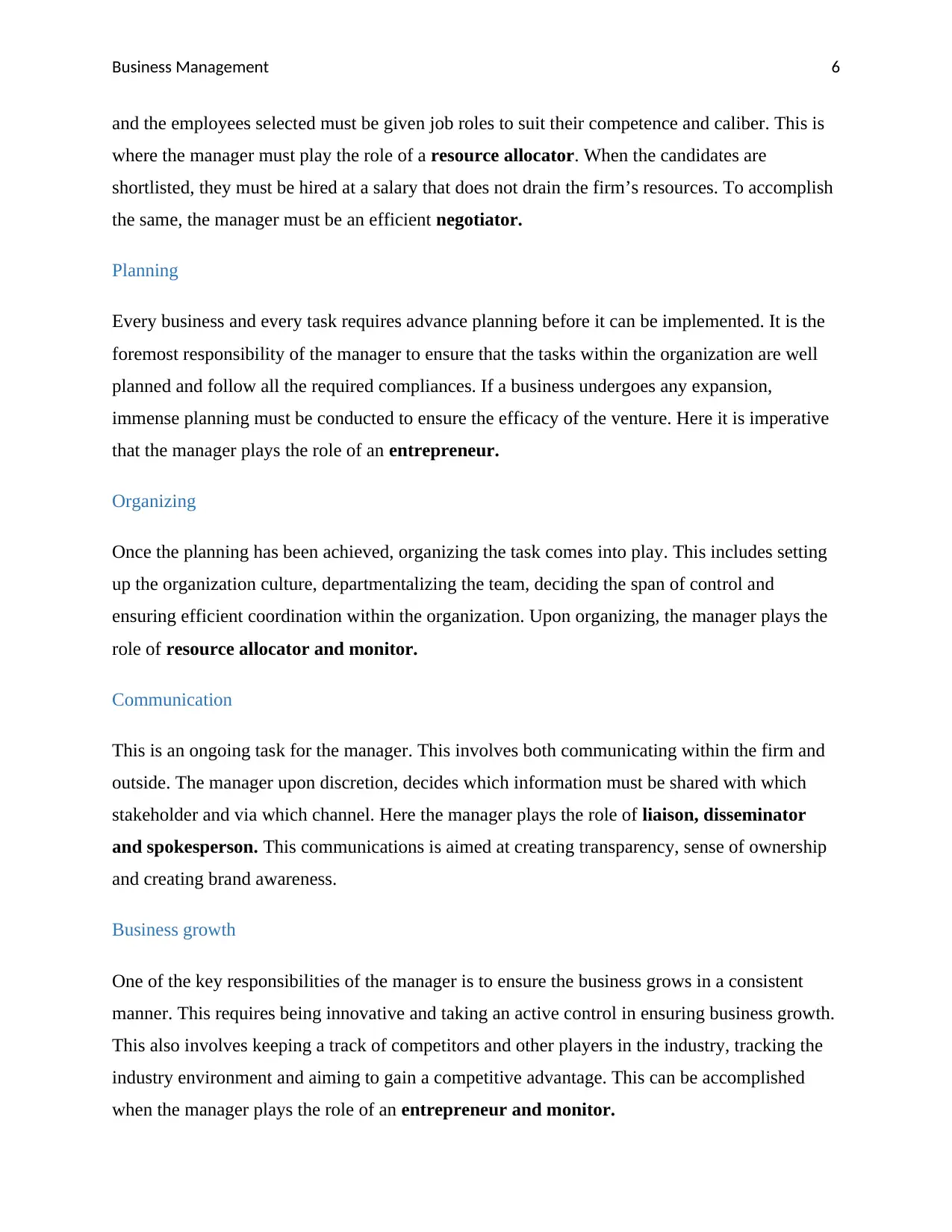
Business Management 6
and the employees selected must be given job roles to suit their competence and caliber. This is
where the manager must play the role of a resource allocator. When the candidates are
shortlisted, they must be hired at a salary that does not drain the firm’s resources. To accomplish
the same, the manager must be an efficient negotiator.
Planning
Every business and every task requires advance planning before it can be implemented. It is the
foremost responsibility of the manager to ensure that the tasks within the organization are well
planned and follow all the required compliances. If a business undergoes any expansion,
immense planning must be conducted to ensure the efficacy of the venture. Here it is imperative
that the manager plays the role of an entrepreneur.
Organizing
Once the planning has been achieved, organizing the task comes into play. This includes setting
up the organization culture, departmentalizing the team, deciding the span of control and
ensuring efficient coordination within the organization. Upon organizing, the manager plays the
role of resource allocator and monitor.
Communication
This is an ongoing task for the manager. This involves both communicating within the firm and
outside. The manager upon discretion, decides which information must be shared with which
stakeholder and via which channel. Here the manager plays the role of liaison, disseminator
and spokesperson. This communications is aimed at creating transparency, sense of ownership
and creating brand awareness.
Business growth
One of the key responsibilities of the manager is to ensure the business grows in a consistent
manner. This requires being innovative and taking an active control in ensuring business growth.
This also involves keeping a track of competitors and other players in the industry, tracking the
industry environment and aiming to gain a competitive advantage. This can be accomplished
when the manager plays the role of an entrepreneur and monitor.
and the employees selected must be given job roles to suit their competence and caliber. This is
where the manager must play the role of a resource allocator. When the candidates are
shortlisted, they must be hired at a salary that does not drain the firm’s resources. To accomplish
the same, the manager must be an efficient negotiator.
Planning
Every business and every task requires advance planning before it can be implemented. It is the
foremost responsibility of the manager to ensure that the tasks within the organization are well
planned and follow all the required compliances. If a business undergoes any expansion,
immense planning must be conducted to ensure the efficacy of the venture. Here it is imperative
that the manager plays the role of an entrepreneur.
Organizing
Once the planning has been achieved, organizing the task comes into play. This includes setting
up the organization culture, departmentalizing the team, deciding the span of control and
ensuring efficient coordination within the organization. Upon organizing, the manager plays the
role of resource allocator and monitor.
Communication
This is an ongoing task for the manager. This involves both communicating within the firm and
outside. The manager upon discretion, decides which information must be shared with which
stakeholder and via which channel. Here the manager plays the role of liaison, disseminator
and spokesperson. This communications is aimed at creating transparency, sense of ownership
and creating brand awareness.
Business growth
One of the key responsibilities of the manager is to ensure the business grows in a consistent
manner. This requires being innovative and taking an active control in ensuring business growth.
This also involves keeping a track of competitors and other players in the industry, tracking the
industry environment and aiming to gain a competitive advantage. This can be accomplished
when the manager plays the role of an entrepreneur and monitor.
Paraphrase This Document
Need a fresh take? Get an instant paraphrase of this document with our AI Paraphraser
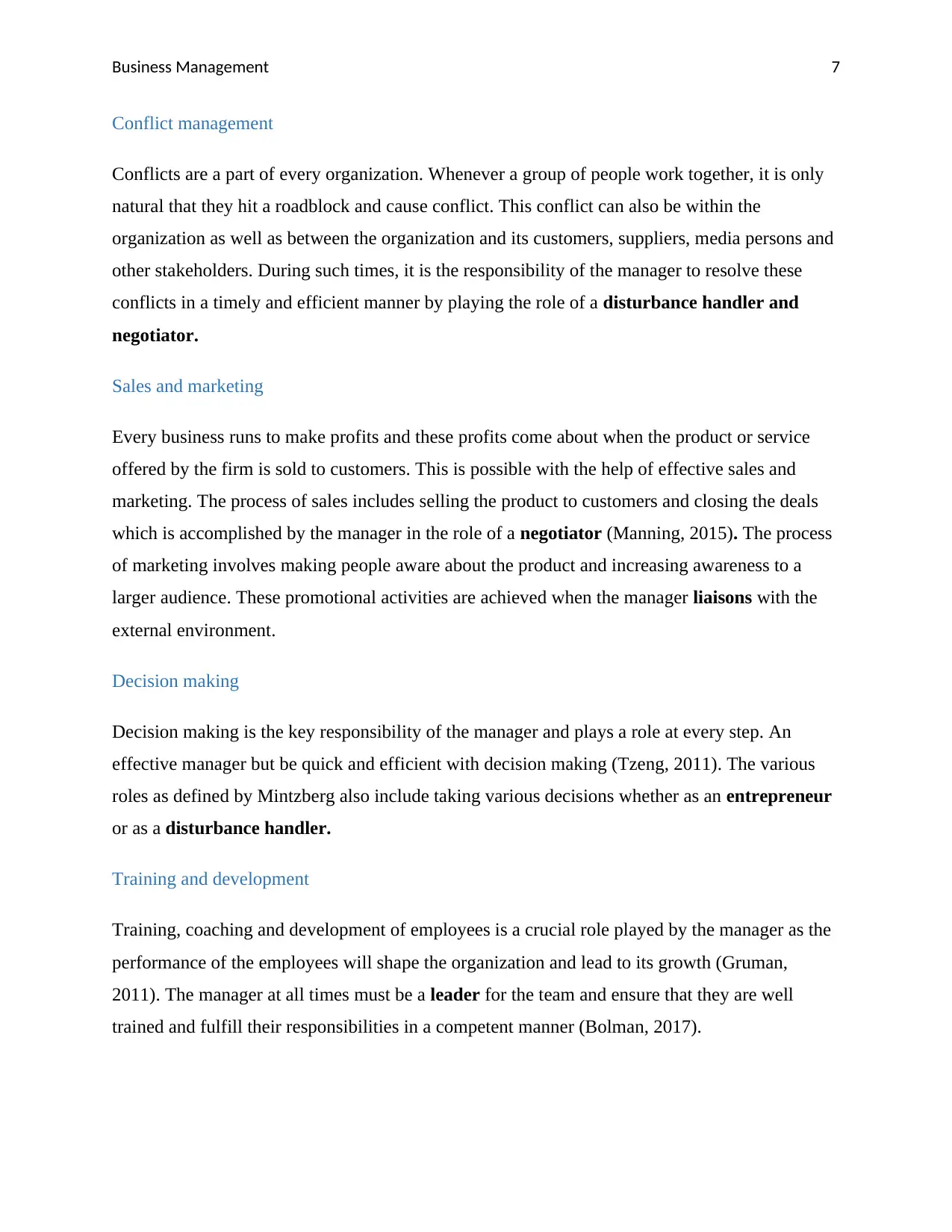
Business Management 7
Conflict management
Conflicts are a part of every organization. Whenever a group of people work together, it is only
natural that they hit a roadblock and cause conflict. This conflict can also be within the
organization as well as between the organization and its customers, suppliers, media persons and
other stakeholders. During such times, it is the responsibility of the manager to resolve these
conflicts in a timely and efficient manner by playing the role of a disturbance handler and
negotiator.
Sales and marketing
Every business runs to make profits and these profits come about when the product or service
offered by the firm is sold to customers. This is possible with the help of effective sales and
marketing. The process of sales includes selling the product to customers and closing the deals
which is accomplished by the manager in the role of a negotiator (Manning, 2015). The process
of marketing involves making people aware about the product and increasing awareness to a
larger audience. These promotional activities are achieved when the manager liaisons with the
external environment.
Decision making
Decision making is the key responsibility of the manager and plays a role at every step. An
effective manager but be quick and efficient with decision making (Tzeng, 2011). The various
roles as defined by Mintzberg also include taking various decisions whether as an entrepreneur
or as a disturbance handler.
Training and development
Training, coaching and development of employees is a crucial role played by the manager as the
performance of the employees will shape the organization and lead to its growth (Gruman,
2011). The manager at all times must be a leader for the team and ensure that they are well
trained and fulfill their responsibilities in a competent manner (Bolman, 2017).
Conflict management
Conflicts are a part of every organization. Whenever a group of people work together, it is only
natural that they hit a roadblock and cause conflict. This conflict can also be within the
organization as well as between the organization and its customers, suppliers, media persons and
other stakeholders. During such times, it is the responsibility of the manager to resolve these
conflicts in a timely and efficient manner by playing the role of a disturbance handler and
negotiator.
Sales and marketing
Every business runs to make profits and these profits come about when the product or service
offered by the firm is sold to customers. This is possible with the help of effective sales and
marketing. The process of sales includes selling the product to customers and closing the deals
which is accomplished by the manager in the role of a negotiator (Manning, 2015). The process
of marketing involves making people aware about the product and increasing awareness to a
larger audience. These promotional activities are achieved when the manager liaisons with the
external environment.
Decision making
Decision making is the key responsibility of the manager and plays a role at every step. An
effective manager but be quick and efficient with decision making (Tzeng, 2011). The various
roles as defined by Mintzberg also include taking various decisions whether as an entrepreneur
or as a disturbance handler.
Training and development
Training, coaching and development of employees is a crucial role played by the manager as the
performance of the employees will shape the organization and lead to its growth (Gruman,
2011). The manager at all times must be a leader for the team and ensure that they are well
trained and fulfill their responsibilities in a competent manner (Bolman, 2017).

Business Management 8
Financial management
Finances are one of the most crucial resources of any organization. The manager must ensure
that the firm makes a profit, does not spend or lose money unnecessarily, no department is
underfunded and a continuous flow of funds in maintained (Brigham, 2012). When the manager
plays the role of resource allocator, this can be accomplished.
Performance management
The performance of the team is directly related to the manager. Hence the manager must keep a
hawk eye’s view on the performance of team, evaluate it on a regular basis, and provide honest
feedback and ensuring improvement. This is achieved when the manager becomes a monitor,
sets clear target for the employees, ensure these targets are achieved and plan accordingly if they
are not (Griffin, 2011).
Motivation
In the stressful world that we live in, it is important and beneficial if the manager is someone the
team can look up to and motivate on a regular basis. This keeps the morale of the employees in
place and encourages them to fulfil their responsibilities and achieve goals. The manager must
become a true leader and a figurehead for the team in order to ensure that the team remained
motivated to work hard (Raelin, 2011). This also helps in building and sustaining a positive
atmosphere in the environment which in turn greatly impacts performance.
Representation
There are a number of public appearances that the manager needs to give in order to represent
the team or organization. This is a big responsibility and the manager must be an efficient
spokesperson in order to ensure that the brand image and positioning of the firm remains intact
in the minds of the larger audience.
Conclusion
The business scenario is no longer what it used to be. The current era is of increasing
competition and spreading globalization. Therefore the managers of the organizations have
Financial management
Finances are one of the most crucial resources of any organization. The manager must ensure
that the firm makes a profit, does not spend or lose money unnecessarily, no department is
underfunded and a continuous flow of funds in maintained (Brigham, 2012). When the manager
plays the role of resource allocator, this can be accomplished.
Performance management
The performance of the team is directly related to the manager. Hence the manager must keep a
hawk eye’s view on the performance of team, evaluate it on a regular basis, and provide honest
feedback and ensuring improvement. This is achieved when the manager becomes a monitor,
sets clear target for the employees, ensure these targets are achieved and plan accordingly if they
are not (Griffin, 2011).
Motivation
In the stressful world that we live in, it is important and beneficial if the manager is someone the
team can look up to and motivate on a regular basis. This keeps the morale of the employees in
place and encourages them to fulfil their responsibilities and achieve goals. The manager must
become a true leader and a figurehead for the team in order to ensure that the team remained
motivated to work hard (Raelin, 2011). This also helps in building and sustaining a positive
atmosphere in the environment which in turn greatly impacts performance.
Representation
There are a number of public appearances that the manager needs to give in order to represent
the team or organization. This is a big responsibility and the manager must be an efficient
spokesperson in order to ensure that the brand image and positioning of the firm remains intact
in the minds of the larger audience.
Conclusion
The business scenario is no longer what it used to be. The current era is of increasing
competition and spreading globalization. Therefore the managers of the organizations have
⊘ This is a preview!⊘
Do you want full access?
Subscribe today to unlock all pages.

Trusted by 1+ million students worldwide
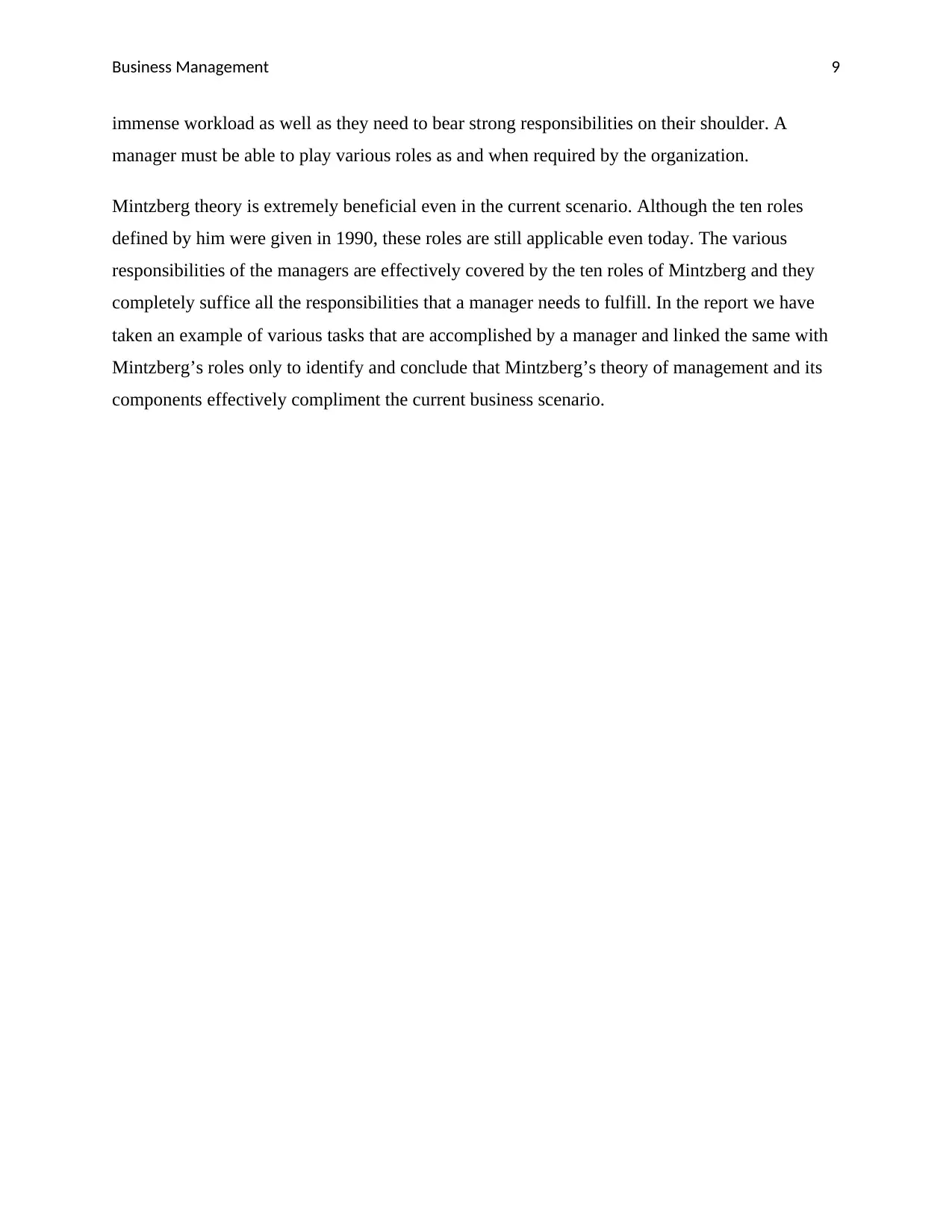
Business Management 9
immense workload as well as they need to bear strong responsibilities on their shoulder. A
manager must be able to play various roles as and when required by the organization.
Mintzberg theory is extremely beneficial even in the current scenario. Although the ten roles
defined by him were given in 1990, these roles are still applicable even today. The various
responsibilities of the managers are effectively covered by the ten roles of Mintzberg and they
completely suffice all the responsibilities that a manager needs to fulfill. In the report we have
taken an example of various tasks that are accomplished by a manager and linked the same with
Mintzberg’s roles only to identify and conclude that Mintzberg’s theory of management and its
components effectively compliment the current business scenario.
immense workload as well as they need to bear strong responsibilities on their shoulder. A
manager must be able to play various roles as and when required by the organization.
Mintzberg theory is extremely beneficial even in the current scenario. Although the ten roles
defined by him were given in 1990, these roles are still applicable even today. The various
responsibilities of the managers are effectively covered by the ten roles of Mintzberg and they
completely suffice all the responsibilities that a manager needs to fulfill. In the report we have
taken an example of various tasks that are accomplished by a manager and linked the same with
Mintzberg’s roles only to identify and conclude that Mintzberg’s theory of management and its
components effectively compliment the current business scenario.
Paraphrase This Document
Need a fresh take? Get an instant paraphrase of this document with our AI Paraphraser
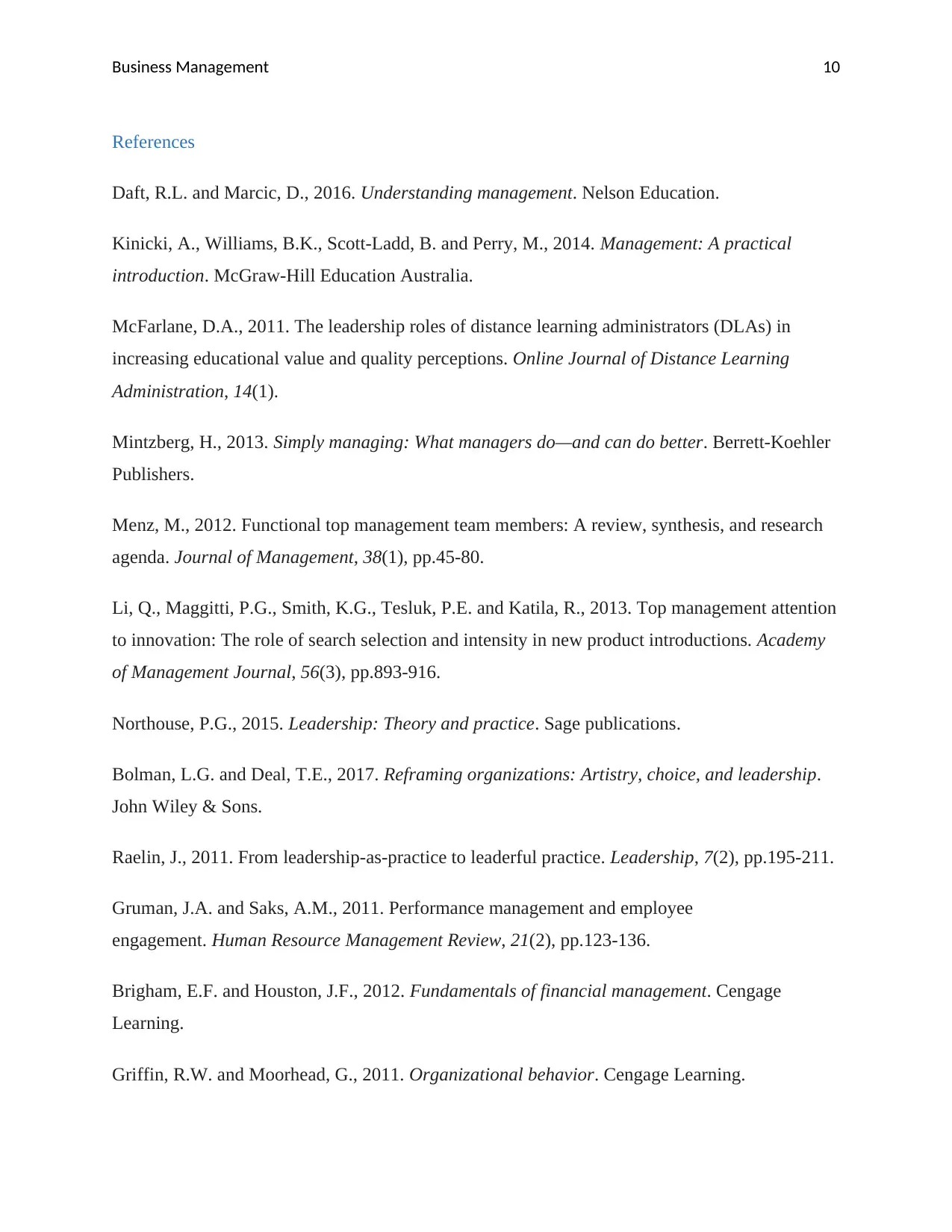
Business Management 10
References
Daft, R.L. and Marcic, D., 2016. Understanding management. Nelson Education.
Kinicki, A., Williams, B.K., Scott-Ladd, B. and Perry, M., 2014. Management: A practical
introduction. McGraw-Hill Education Australia.
McFarlane, D.A., 2011. The leadership roles of distance learning administrators (DLAs) in
increasing educational value and quality perceptions. Online Journal of Distance Learning
Administration, 14(1).
Mintzberg, H., 2013. Simply managing: What managers do—and can do better. Berrett-Koehler
Publishers.
Menz, M., 2012. Functional top management team members: A review, synthesis, and research
agenda. Journal of Management, 38(1), pp.45-80.
Li, Q., Maggitti, P.G., Smith, K.G., Tesluk, P.E. and Katila, R., 2013. Top management attention
to innovation: The role of search selection and intensity in new product introductions. Academy
of Management Journal, 56(3), pp.893-916.
Northouse, P.G., 2015. Leadership: Theory and practice. Sage publications.
Bolman, L.G. and Deal, T.E., 2017. Reframing organizations: Artistry, choice, and leadership.
John Wiley & Sons.
Raelin, J., 2011. From leadership-as-practice to leaderful practice. Leadership, 7(2), pp.195-211.
Gruman, J.A. and Saks, A.M., 2011. Performance management and employee
engagement. Human Resource Management Review, 21(2), pp.123-136.
Brigham, E.F. and Houston, J.F., 2012. Fundamentals of financial management. Cengage
Learning.
Griffin, R.W. and Moorhead, G., 2011. Organizational behavior. Cengage Learning.
References
Daft, R.L. and Marcic, D., 2016. Understanding management. Nelson Education.
Kinicki, A., Williams, B.K., Scott-Ladd, B. and Perry, M., 2014. Management: A practical
introduction. McGraw-Hill Education Australia.
McFarlane, D.A., 2011. The leadership roles of distance learning administrators (DLAs) in
increasing educational value and quality perceptions. Online Journal of Distance Learning
Administration, 14(1).
Mintzberg, H., 2013. Simply managing: What managers do—and can do better. Berrett-Koehler
Publishers.
Menz, M., 2012. Functional top management team members: A review, synthesis, and research
agenda. Journal of Management, 38(1), pp.45-80.
Li, Q., Maggitti, P.G., Smith, K.G., Tesluk, P.E. and Katila, R., 2013. Top management attention
to innovation: The role of search selection and intensity in new product introductions. Academy
of Management Journal, 56(3), pp.893-916.
Northouse, P.G., 2015. Leadership: Theory and practice. Sage publications.
Bolman, L.G. and Deal, T.E., 2017. Reframing organizations: Artistry, choice, and leadership.
John Wiley & Sons.
Raelin, J., 2011. From leadership-as-practice to leaderful practice. Leadership, 7(2), pp.195-211.
Gruman, J.A. and Saks, A.M., 2011. Performance management and employee
engagement. Human Resource Management Review, 21(2), pp.123-136.
Brigham, E.F. and Houston, J.F., 2012. Fundamentals of financial management. Cengage
Learning.
Griffin, R.W. and Moorhead, G., 2011. Organizational behavior. Cengage Learning.
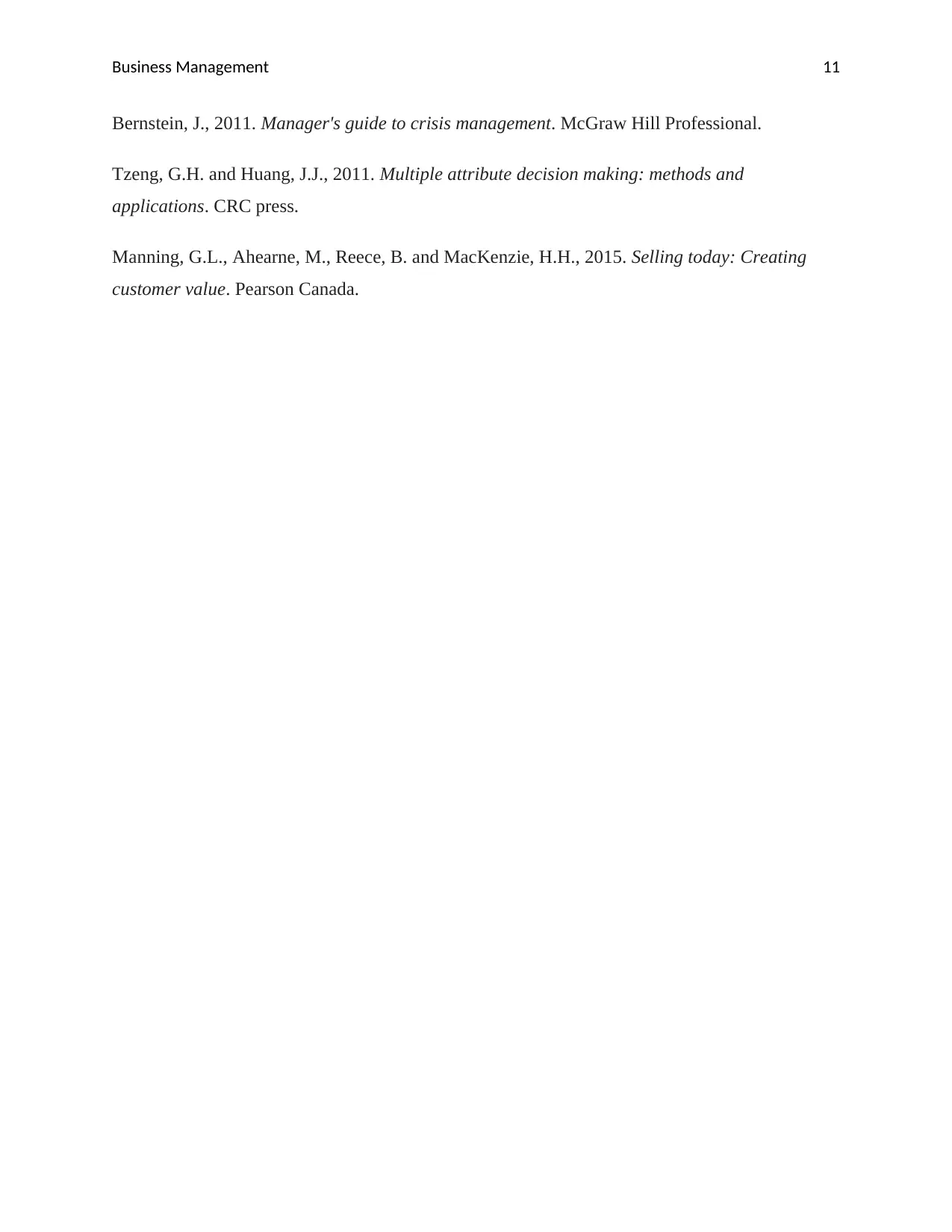
Business Management 11
Bernstein, J., 2011. Manager's guide to crisis management. McGraw Hill Professional.
Tzeng, G.H. and Huang, J.J., 2011. Multiple attribute decision making: methods and
applications. CRC press.
Manning, G.L., Ahearne, M., Reece, B. and MacKenzie, H.H., 2015. Selling today: Creating
customer value. Pearson Canada.
Bernstein, J., 2011. Manager's guide to crisis management. McGraw Hill Professional.
Tzeng, G.H. and Huang, J.J., 2011. Multiple attribute decision making: methods and
applications. CRC press.
Manning, G.L., Ahearne, M., Reece, B. and MacKenzie, H.H., 2015. Selling today: Creating
customer value. Pearson Canada.
⊘ This is a preview!⊘
Do you want full access?
Subscribe today to unlock all pages.

Trusted by 1+ million students worldwide
1 out of 12
Related Documents
Your All-in-One AI-Powered Toolkit for Academic Success.
+13062052269
info@desklib.com
Available 24*7 on WhatsApp / Email
![[object Object]](/_next/static/media/star-bottom.7253800d.svg)
Unlock your academic potential
Copyright © 2020–2025 A2Z Services. All Rights Reserved. Developed and managed by ZUCOL.




